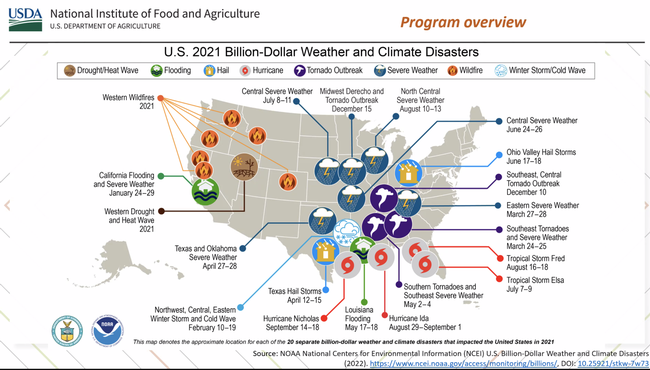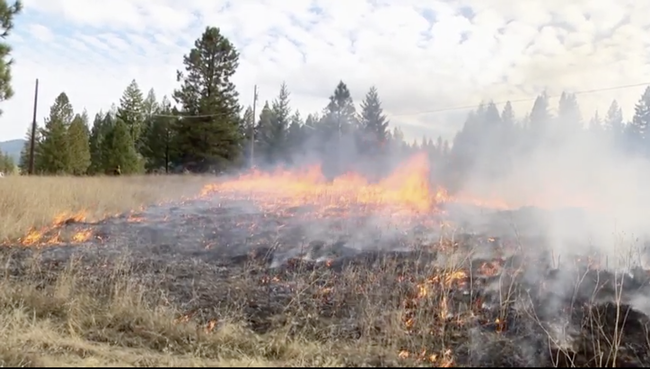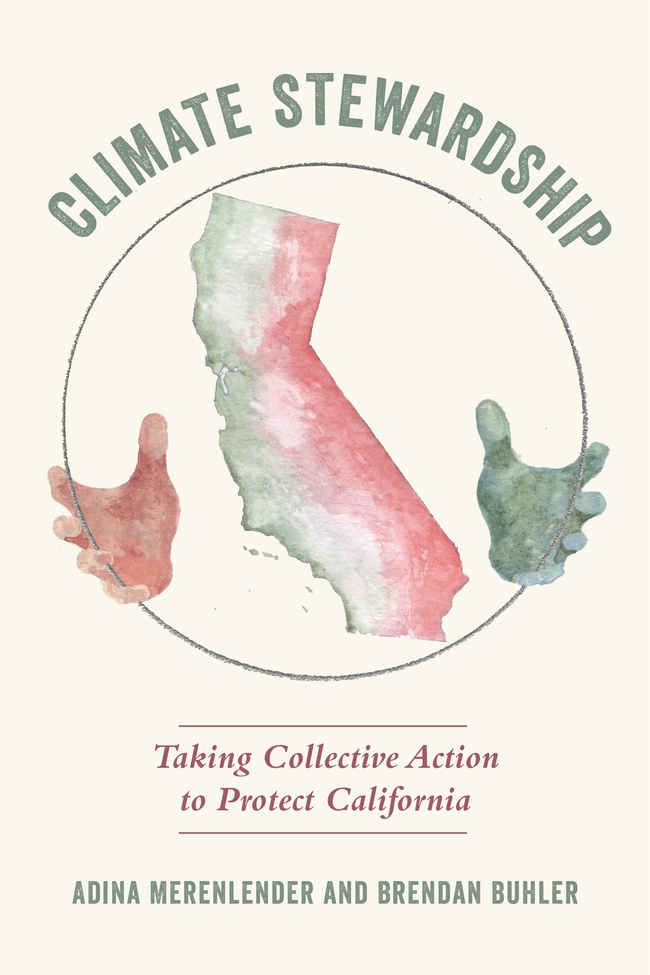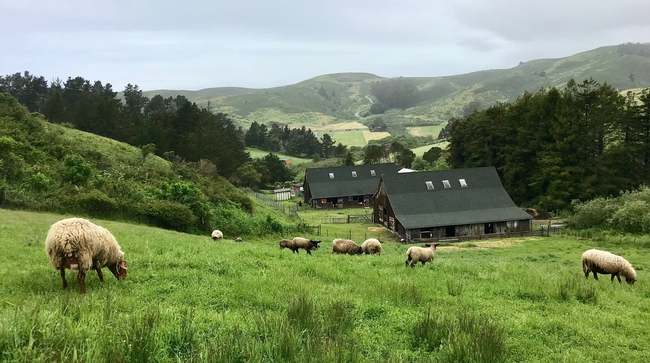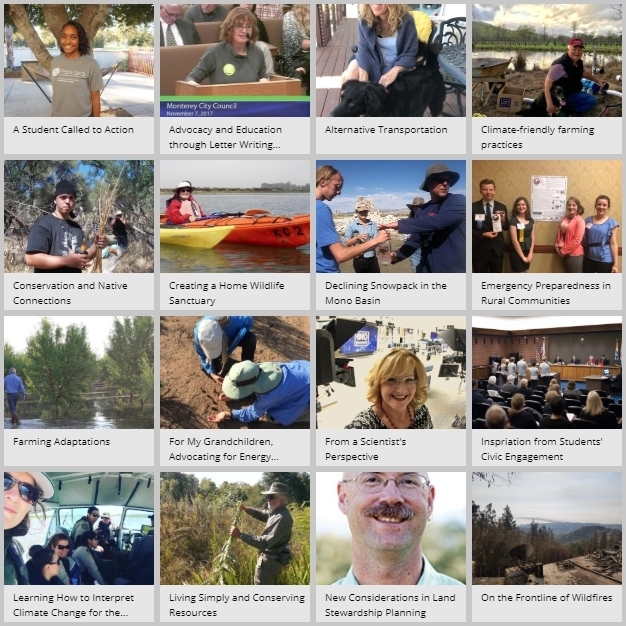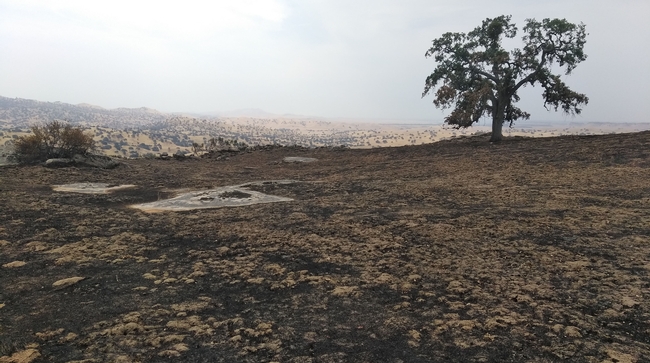- Author: Derecka Alexander, American Association for the Advancement of Science Policy Fellow
Informational webinars on Sept. 14, Dec. 8
The increase in the intensity and frequency of extreme weather-related disasters across the country may have many of us wishing we could click our heels and go back to times when weather did not disrupt our agricultural, forestry and rangeland production systems as often as it does today.
In addition to their devastating impacts on people and communities, disasters contribute to land degradation and adversely impact agricultural supply chains at the production, processing, distribution and consumption stages.
In response to extreme temperatures, heavy downpours, droughts and blizzards, USDA's National Institute of Food and Agriculture is introducing a new program to help communities protect the nation's food supply.
The Rapid Response to Extreme Weather Events Across Food and Agricultural Systems program reflects a new cross-cutting program area within NIFA's Agriculture and Food Research Initiative. The program is housed within AFRI's Foundational and Applied Science program and is designed to rapidly deploy strategies, and fill knowledge and information gaps to protect the nation's food and agricultural supply chains — at the production through consumption stages — during and after extreme weather disasters.
Disasters happen when a community is not appropriately resourced or organized to withstand the impact, and whose population is vulnerable because of poverty, exclusion or other social disadvantages, according to United Nations Office for Risk Reduction official Mami Mizutori.
The new program area contains two grant types: Strengthening Standard and Coordinated Agricultural Project. Project proposals for either grant type will directly address effects associated with an extreme weather event or disaster that has occurred. In addition, applications will present projects that address one or more of the following emphasis areas:
- Agroecosystem Resilience
- Agricultural Commodity and Nutrition Security
- Health, Well-Being and Safety
The intention of the Rapid Response to Extreme Weather Events Across Food and Agricultural Systems program is to fund projects that provide solutions, which may include trainings, communication strategies, tools and technologies, food supply logistics, and climate-smart practices that can be rapidly adopted by various end-users. These projects will also explain how adoption potential of proposed solutions will be measured.
NIFA is committed to alleviating the impacts of extreme weather events and disasters across the food and agricultural system. NIFA understands the importance of supporting timely, critical research and Extension activities following extreme weather events and disasters.
For more information, or if you have any questions about this new program area priority, please visit AFRI Foundational and Applied Science RFA or send an email to afri-rapidresponse@usda.gov.
Live FAQ webinars will be held at noon on Sept. 14 and Dec. 8. Please check NIFA's events page to register for upcoming live Q&As.
When planning a proposal that includes communication, contact Linda Forbes, director of UC ANR Strategic Communications, at lforbes@ucanr.edu.
- Author: Pamela Kan-Rice
Wildfires that generate their own weather, drought, record-breaking heatwaves, and frequent flooding are compelling more people to try to mitigate and adapt to climate change. A new book co-authored by Adina Merenlender, UC Cooperative Extension specialist at UC Berkeley, shows how Californians are working together across diverse communities and landscapes to improve resilience and address climate justice.
“Climate Stewardship: Taking Collective Action to Protect California,” published by UC Press, will be required reading for participants of the UC Climate Stewards certification course, but it isn't a textbook. The book is a collection of personal stories of individuals who are striving to improve climate resilience.
“The stories, many gathered through UCCE extension efforts, show what everyday people can do together to improve community resilience across agricultural, natural and urban landscapes,” Merenlender said. “'Climate Stewardship' also offers an uplifting way to learn about climate science that is most relevant for California's communities and ecosystems.”
Merenlender suggests UC ANR colleagues consider sharing the book, which is written for a lay audience, with their clientele.
“It is written in narrative form with stories meant to showcase what can be done and some relevant climate science is woven throughout,” she said. “For this reason, it is meant to be of interest to a wide California audience.”
The book is illustrated with original paintings by Obi Kaufmann, author of “The California Field Atlas,” and co-authored by Brendan Buhler, an award-winning science writer.
For more information about the book, see the California Naturalist blog at http://calnat.ucanr.edu/cs/Climate_Stewardship. To buy the book with a 30% discount, use code 20W8895 at https://www.ucpress.edu/book/9780520378940/climate-stewardship.
- Author: Jeannette E. Warnert
UC ANR employees interested in incorporating responses to climate change into their programs are invited to a symposium Oct. 7-8 at Elkus Ranch in Half Moon Bay. The focus will be on the national dialog around contemporary federal climate-change policy as it relates to agriculture and natural resource management.
“We see this event as one that will help our colleagues reflect on our work and generate new ideas for climate change- and environmental justice-related extension activities,” said Clare Gupta, UCCE specialist in human and community development and one of the event organizers. “The symposium will provide a space to learn about the current climate-change policy landscape, and what a viable and just federal climate-change policy might entail.”
Topics include:
- What are different policy strategies for addressing climate change in the realms of agriculture, food systems and natural resource management?
- How do these strategies incorporate concerns over equity and justice?
- What are the implications for UCANR's involvement?
- Our keynote and panel speakers will speak to current federal climate change efforts, possible ways forward, and potential roles for UCCE.
The symposium is free. Travel funds are not available. To register, go to https://ucanr.edu/survey/survey.cfm?surveynumber=28169.
- Author: Andy Lyons
IGIS and the California Naturalist Program are pleased to help celebrate the launch of a new information portal on climate adaptation. The California Adaptation Clearinghouse was officially launched at the California Adaptation Forum in August in Sacramento. The site was developed by the Governor's Office of Planning and Research (OPR) in collaboration with the UC Berkeley Geospatial Innovation Facility, CalNat and IGIS.
The Clearinghouse is a database-driven platform with a wealth of curated resources for climate adaptation. The site originated out of Senate Bill 246, which mandates OPR to provide resources on climate adaptation for local governments, regional planning agencies, and other practitioners working on adaptation and resilience. The database also contains sea-level rise resources collected by the Ocean Protection Council under Assembly Bill 2516. It's an amazing resource for anyone looking to strengthen climate change preparedness in their local government, community, or business.
The database includes numerous planning resources that have been developed and vetted by experts in the field. For example, the Urban Sustainability Directors Network has a how-to guide for local governments on developing equitable, community-driven climate preparedness plans, which you can find in the Clearinghouse. There are also examples of vulnerability assessments, local plans, and funding strategies. The majority of resources are hosted by other organizations, but unlike a Google search all the resources in the Clearinghouse have been reviewed, annotated, and cataloged by subject matter specialists.
To help find resources, the Clearinghouse has a number of search options, including more than a dozen topic categories adapted from Safeguarding California, the state's overall roadmap for building climate change resiliency. You can also search by Type of Impact (e.g., drought, sea level rise), Resource Type (e.g., case study, assessment, policy guidance), and of course an interactive map. Each resource has a descriptive blurb so you can quickly find what you need.
Adaptation planning can be information intensive, so the Tools and Data section of the website is devoted to helping people find data and crunch the numbers. Interested in rangelands? Check out the CA Landscape Conservation Cooperative's compiled Threat Assessments to California Rangelands. Sea level rise? Perhaps the CosMos modeling tool from USGS, or the Surging Seas tool from Climate Central. Like all resources, each tool and dataset has a user-friendly description, a technical summary, a bit about the data, and links to the source. One of our favorites is the California Energy Commission's Cal-Adapt, which includes both historical and projected climate data downscaled for California.
Providing a more personal perspective, the Clearinghouse also contains stories about climate adaptation from individuals, community groups, and businesses. The stories were collected by the UC ANR California Naturalist Program and their vast network of certified naturalists. The climate stories are diverse and compelling, from a concerned grandmother who becomes engaged in a community choice energy program, to a solar project engineer working to strengthen measures to prevent heat stroke in field staff. An interactive Story Map developed by IGIS helps users find stories from their area, some of which even have audio or video clips so you can hear the story in the speaker's own words.
Climate adaptation is complicated, but information portals like the Clearinghouse allow anyone to tap into the incredible amount of work that has already been done in California and elsewhere. Rather than reinvent the wheel, local agencies can build upon vetted guidelines from similar areas. We are all fortunate that the State of California has invested in a platform to share curated resources for the long-term, because climate adaptation is already part of the new normal. More resources are in the pipeline, so check it out and then check back often to see what's new.
- Author: Pamela Kan-Rice
Climate change is one of the greatest challenges facing farmers, natural resource managers and communities in California.
On Jan. 23-24, the Climate Change Program Team will hold the Integrating Climate Change in California Cooperative Extension Programs Workshop at UC Merced.
“It's open to all ANR academics and program staff who are interested in the topic,” said Ted Grantham, UC Cooperative Extension specialist in the Department of Environmental Science, Policy, and Management at UC Berkeley.
“This meeting will bring together ANR academics and programmatic staff to strengthen interdisciplinary collaborations and enhance the capacity of UC Cooperative Extension to advance climate-change mitigation and adaptation efforts in California,” he said.
The day-and-a-half-long workshop will include updates on the latest science on climate impacts and sessions that focus on disaster preparedness and response, climate science communication, and climate-smart agriculture. The workshop will also include interactive dialog to identify priorities for enhancing the visibility, relevance and impact of ANR's climate-change research and extension programs.
In breakout sessions, participants will discuss wildfire hazard mitigation, environmental education and citizen science, building climate resilience with tribes and vulnerable communities, environmental horticulture and more.
To register and view the draft agenda, visit https://ucanr.edu/sites/CalClimateChange/2019_Workshop.

